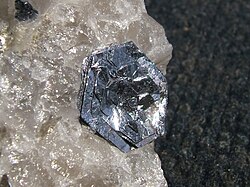Molybdenum ore, Climax CO
Climax Mine molybdenum ore (5.3 cm across at its base) - molybdenite-quartz veins in alkaline granite from the Climax Mine, Lake County, central Colorado, USA.
Dark silvery gray = molybdenite (MoS2). Medium gray = quartz Light colored areas = alkaline granite
Central Colorado’s Climax Mine is the largest molybdenum mine on Earth. It's located in the Southern Rocky Mountains, near the northern end of the Rio Grande Rift, a large, Neogene-aged rift valley on the eastern side of the Colorado Plateau.
Molybdenum (Mo - “moly”) mineralization at the Climax Mine occurred as a series of igneous bodies intruded through Proterozoic basement rocks (gneisses and granites). Seven intrusive bodies make up the composite Climax Stock (Oligocene, 24-33 m.y.). Three of them produced significant moly mineralization in the form of molybdenite-quartz veins and disseminated molybdenite (MoS2 - molybdenum sulfide).
The rocks of the Climax Stock are alkaline felsic intrusives. They range from porphyritic alkaline rhyolites to alkaline aplites to porphyritic alkaline granites. In map view, the igneous bodies of the Climax Stock form a roughly circular structure. In cross-section view, each intrusion has an inverted bowl shape.
Published studies on the origin of the Climax Molybdenum Deposit and other Climax-type moly deposits have concluded that they form principally in incipient extensional tectonic settings well inland from shallow-angle subduction zones that have recently ceased.Relevante Bilder
Relevante Artikel
MolybdänitMolybdänit, veraltet auch als Molybdänglanz, Eutomglanz oder Wasserblei bekannt, ist ein häufig vorkommendes Mineral aus der Mineralklasse der „Sulfide und Sulfosalze“. Es kristallisiert im hexagonalen Kristallsystem mit der Zusammensetzung MoS2, ist also chemisch gesehen ein Molybdändisulfid bzw. Molybdän(IV)-sulfid. .. weiterlesen



